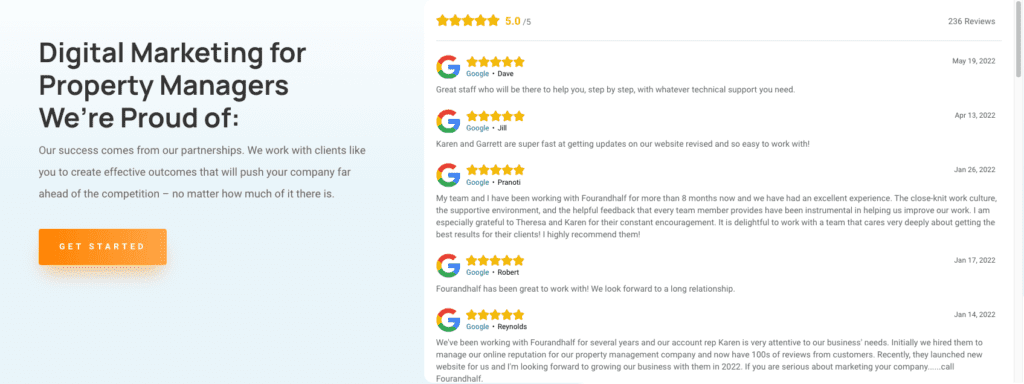Summary
Landing pages for property managers serve a specific purpose: to convert leads by guiding owner prospects to take a clear, desired action, like filling out a contact form or making a call. Unlike a homepage, which serves many audiences, landing pages are laser-focused and should be built around one audience: property owners. A strong landing page includes local visuals, a clear headline, a compelling call to action above the fold, concise value propositions, a simple form, and social proof like testimonials. The goal is to capture interest quickly, avoid distractions, and make it easy for owners to reach out.
What’s the purpose of your landing page?
Landing pages for property managers are different than website pages. They are out there on their own – serving a specific purpose and leading visitors to the desired action you’re hoping for, whether it’s a contact, a request for more information, or a purchase. You send people to your landing page through an email, a newsletter, an ad, or any link you manage to get out there in the digital space.
You don’t have a lot of time to capture the attention of your landing page visitors. If they don’t find value as soon as they land there, off they’ll go. Your landing page needs to be optimized for conversions so that prospects will stick around and engage with your brand.

Landing Pages for Property Managers
When it comes to effective landing pages, these should be the questions you’re asking yourself:
- What’s on a landing page?
- What should a landing page look like?
- How can you use them to generate leads and close your business?
Every Landing Page Needs a Purpose

As we dive into the details of landing pages for property managers and how to use them, let’s not forget the WHY.
WHY work with landing pages when there’s a dizzying number of digital marketing tools and platforms you can use?
Because the landing page serves all those other marketing tools. The purpose of a landing page is to gather potential customers.
Instead of directing prospects to the homepage of your website, which is designed for everyone, and is sometimes an easy place to get lost, you’re sending them to a page that is specifically and exclusively targeted to them: owner leads.
Frank Gorshin, an actor from back in the day, said something that’s pretty relevant to thinking about your landing page:

Have you ever gone fishing?
If you want to catch trout, you need to use trout bait. Otherwise, you’ll catch a lot of other fish. But not that trout.
You need a fine and specific bait. Then, you’ll quickly catch the fish you want.
If you’ve never fished or struggled with finding the right bait, you might prefer to think about your landing page as a traffic cop. When you’re at an intersection with cars and pedestrians and bikers coming and going in and from multiple directions without a stop sign or a traffic light, you need some direction.

That’s where the traffic cop comes in – standing in the middle of the busy intersection, probably with a whistle, waving people through, and holding up a hand to keep them in place.
Your website homepage has a lot of traffic moving in different directions. You’ve got tenants looking for their portal so they can pay rent or make a maintenance request. You’ve got current owners showing up to read your latest blog post. There are renters looking at your available properties. There’s a lot happening.
You don’t want your potential leads showing up and getting lost.
You don’t want them sharing space with all those other audiences your website is set up to serve.
So, you have your landing page. There are very limited things your landing page visitor can do when they arrive on that site. They’ll call you or email you. They’ll fill out a contact form. Those calls to action are specific and they’re targeted to the visitors who arrived on your landing page for a reason.
It’s a finer bait. Your landing page results in a shorter wait when it comes to reeling in new business.
Before Getting Started on Your Landing Page
An effective landing page will convince your prospect – a landlord or a real estate investor searching for a local property management company – that you are the best in the area.
Your landing page will tell them that you’re the only company they want to work with.
This is where you showcase who you are, what you do, and why you’re different.
The ultimate purpose of your landing page is to persuade landlords and owners that you’re the best choice when it comes to managing their investment property.
We’re going to take a look at the components of a good landing page and what you’ll need to include when you’re making your case.
This isn’t rocket science. But it is pretty nuanced, depending on your market and your perfect client.
So before you dive into a landing page investment, let us suggest that:
- You know your market. Like…really know your market. Better than any of your competition.
- You know your perfect client. Are you focused on bringing self-managing landlords into professional management? Do you hope to convince owners who have their homes managed elsewhere to come work with you instead? Are hands-off investors your perfect clients? Out of state owners? People who have just bought their first rental home?
You need to know what is renting in your area and who is renting those homes out.
Even more important – you need to know who you want on your real estate landing page. Take some time to figure this out if you haven’t already.

List of Property Management Landing Page Must-Haves
We put together a list of what you need for a good landing page.
There’s a lot of room for creativity here. But, there are also a few standard and consistent items that have to show up.
1. Landing Pages Need to Reflect Your Services and Area
Where in the world are you?
The first thing a landing page visitor needs to notice in a landing page is the background, which must reflect where you are.
Use photos. Maps. An image of some iconic landmark or monument that your city is known for.

If you’re a property management company in Sarasota, Florida, for example, you might want a beach scene. If you’re working in Charlotte, North Carolina, consider putting an attractive photo of the Charlotte skyline as the background on your landing page. A Las Vegas management company might want a photo of The Strip at night, with casinos looming large against a backdrop of desert mountains.
This kind of imagery will immediately attach your company to a service area. Your visitors will know they are in the right place.
Every landing page needs a title.
These do not have to be long, flowery, or clever titles.
In fact, it’s better to keep things simple and straightforward:
“Sarasota Property Management.”
“Charlotte Property Management.”
“Property Management in Las Vegas, Nevada.”
All of those work. People arriving on your landing page will instantly know where you are and what you do. They’ll see it and they’ll read it.
If leads are coming to this landing page from Google Ads, and you’re targeting multiple cities, you can use dynamic text to make your page hyper-relevant.
Congrats. Checklist Item No. 1 is complete.
2. Landing Pages Need a Clear Call to Action
Contact.
That’s what you want out of a landing page.
You want prospective customers to see who you are, where you are, and what you’re about.
You want them to call you or message you or fill out a form that shares their own contact information so you can get in touch with them.
That’s it. That’s why you have this landing page.
This is the moment that they’re most interested in your services, and you want to reach them right away.
All of the components of the page are working towards this one goal.
Put your Call to Action above the fold.

What does above the fold mean?
It means that as soon as they land on your page, the option is right there – to call you or message you or fill out a form. They don’t have to scroll down the page to find the instructions on how to get in touch.
CONTACT US should be right there on the screen in front of them. Immediately.
Don’t set that Call to Action once and then forget about it.
Ideally, you’ll repeat your phone number periodically as the visitor scrolls down the page, so it’s almost always in view. Have a repeat of the contact form at the end of the page, in case the visitor reads everything you’ve got to say.
Be Concise and Lose the Fluff
Minimal text is better. When we’re talking about educational blogs or informative videos, we want to be a bit wordy. There’s a good opportunity to put everything you know onto the screen or the page so your prospects know you’re the authority on property management in their market.
But, they’re not on your landing page to learn stuff. They’re on your landing page because they need help and you are ready to help them. So let’s not lose them with lengthy paragraphs about the latest rental laws. Let’s not give them too much to overthink when they’re trying to decide whether professional property management is the way to go.
Let’s prompt them to get in touch with you. That is why we’re creating a landing page. There’s a time and a place for the videos, the education, and all the expertise that you have to offer your potential clients. On the landing page, however, less is more. They know something about you already, or they wouldn’t be here.
3. The Form
Yes, we’ve talked about the Contact Form as being part of your Call to Action.
But it’s also a thing on its own.
The Contact Form has to show up again – below the fold.
Why is The Form so important? Because it allows you to prepare for your client contact in advance. Instead of picking up the phone and having the potential client right there, you have a form with some of their most interesting information. You get their name, their phone number, their email address. Most importantly, you have that field where the prospect can tell you what’s on their mind or why they’re reaching out. Maybe they’ll explain the trouble they’ve had with tenants. Or, they’ll talk about investing in your market for the first time.

That’s valuable information that you can use to prepare for your first in-person contact.
Always include The Form on your landing page. Always ask them to fill it out.
4. Why You and Why Now? Your Landing Page Needs Value Propositions
Find a concise, attention-grabbing way to state your value propositions.
Why YOU? Why should they choose your property management company instead of all the others in your market?
This can be difficult to articulate. But a good landing page will do it.
Remember – we don’t want to chase them off the page with large blocks of texts and endless paragraphs saying all the same things about how you collect rent on time and respond to maintenance.
All property managers claim to do that.
What do you do that others don’t? And, how can you explain it in just a few words?
We recommend well-crafted bullet points. Provide four different things that your perfect client is looking for. Show them how you provide those things and why you do it better than anyone else.
Your value propositions need to talk about the benefits of working with you. They need to feel their problems moving out of their hands and into yours.
Focus on solutions to their problems. You always want to speak to the pain points of your prospects. They need to be clear, concise, and easy to understand. It gives them a great reason to contact you.
Not Sure About Your Best Value Propositions?
Let’s Think About Three Things:
- What are your ideal client’s pain points, and how does your property management company solve them?
- What sets you apart from your competitors in the way those problems are solved?
- What objections do you need to overcome (i.e. management fees are too expensive)?
5. Let Your Reputation Speak for Itself
You need to sell yourself on your landing page.
Even better, though, is when other people do the selling for you. This is often referred to as social proof.
This is where we recommend a client testimonials widget. It can help your landing page feel more authoritative. Let your best customers tell your future customers why they need to work with you. Always make sure your phone number and your contact form show up near those testimonials. Someone might read the right review – one that really hits home – and they’ll want to call you right away.
At Fourandhalf, we love working with our testimonial widget from Reputation.com. Our clients love that it features live, verified reviews of your company. This lends a lot of third-party validation to your prospects.
Showcase at least one huge testimonial that makes you proud. Or, ask us for a widget that helps you stream ongoing reviews so your prospective clients know what your customers are saying about you right now.

What Have We Learned Here?
You should be ready to put together an effective and interesting landing page now that you know what it’s here to do.
Your landing page targets your message to your prospects and ignores all the other constituencies that your website has to serve. The only audience for this page is the potential landlord client or real estate investor who might be interested in your services.
Start by ensuring they can easily contact you, prominently featuring a form that gathers valuable information. Highlight your unique value propositions in a way that sets you apart from competitors, using well-crafted bullet points and focusing on your client’s pain points and solutions.
Lastly, let your reputation shine through testimonials or a review widget. Your landing page should target your message directly to prospective clients, encouraging them to take the next step and reach out. It’s one important part of your overall marketing strategy.
Landing Page FAQ for Property Managers
Q: What is a landing page, and how is it different from my website homepage?
A: A landing page is a standalone web page created specifically for marketing or advertising campaigns. Unlike your homepage, which serves multiple audiences (tenants, owners, vendors), a landing page targets a single type of visitor (usually prospective owners) and leads them toward a specific action, like contacting your business.
Q: What should be on my landing page?
A: Key elements include:
- A clear headline with your service area
- A strong, visible call to action
- A short contact form
- Bullet-pointed value propositions
- Local images or recognizable landmarks
- Client testimonials or review widgets
Q: How long should the content on my landing page be?
A: Keep it concise and to the point. Landing pages are not the place for long-form content. Focus on the benefits of your service, not general industry education.
Q: How can I make my landing page stand out from competitors?
A: Use unique value propositions that clearly differentiate your company. Focus on how you solve owner pain points better or more efficiently than others in your market.
Q: What’s the ultimate goal of my landing page?
A: To get qualified owner leads. Every element on the page should work toward convincing the prospect to contact you—and make it easy for them to do so.
Q: Can Fourandhalf help me build a landing page?
A: Absolutely. That’s why we’re here. If you have any questions about landing pages or digital property management marketing in general, you know you can contact us at Fourandhalf.
